|
|
|
|
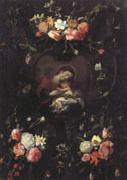 |
Daniel Seghers
|
|
Flemish Baroque Era Painter, 1590-1661
was a Jesuit brother and Flemish Baroque painter who specialized in flower still lifes, and is particularly well-known for his contributions to the genre of "flower garland" painting. His paintings were collected enthusiastically by courtly patrons and he had numerous imitators. Born in Antwerp, Seghers moved to the Dutch Republic around 1601, following the death of his father Pierre and the conversion of his mother to Calvinism.[1] The young artist returned to Antwerp by 1611, where he was enrolled in the guild of St. Luke as a student of Jan Brueghel the Elder.After re-converting back to Catholicism, in 1614 he became a noviciate in the Jesuit order in MechelenUntil 1625 Seghers continued to work as a painter in Antwerp, as well as a stay in Brussels in 1621Sources differ regarding his status in the Jesuit order: some claim that he was ordained a priest in 1625,while other argue that he remained a lay brother. |
|
|
|
|
|
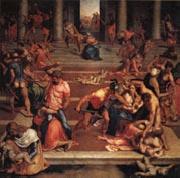 |
Daniele Da Volterra
|
|
Italian Mannerist Painter and Sculptor, 1509-1566
Italian painter, stuccoist and sculptor. Much of the fascination of his career resides in the development of his style from provincial origins to a highly sophisticated manner, combining the most accomplished elements of the art of Michelangelo, Raphael and their Mannerist followers in a distinctive and highly original way. He provided an influential model for numerous later artists in Rome. |
|
 |
Dankvart Dreyer
|
|
(13 June 1816 - 4 November 1852) was a Danish landscape painter of the Copenhagen School of painters who was educated under the guidance of Christoffer Wilhelm Eckersberg. Around 1840, he was part of the emerging National Romantic landscape painting scene in Denmark but as a result of his over-dramatic and excessively natural style, he did not fit the aestetics and the ideology of the period. After being widely criticized, he turned his back on the artistic establishment and passed into near oblivion. In 1852, when only 36 years old, he died from typhus.
Posthumously, half a century after his death, his reputation was restored, prompted by the art historian Karl Madsen, and today he is considered to be one of the leading Danish landscape painters of his day, the peer of his more famous contemporaries P.C. Skovgaard and Johan Lundbye.
|
|
 |
dante alighieri
|
|
Born: 1265
Birthplace: Florence, Italy
Died: September 1321 (Malaria)
Best Known As: The author of The Divine Comedy
|
|
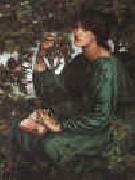 |
Dante Gabriel Rossetti
|
|
English Pre-Raphaelite Painter, 1828-1882
Rossetti's first major paintings display some of the realist qualities of the early Pre-Raphaelite movement. His Girlhood of Mary, Virgin and Ecce Ancilla Domini both portray Mary as an emaciated and repressed teenage girl. His incomplete picture Found was his only major modern-life subject. It depicted a prostitute, lifted up from the street by a country-drover who recognises his old sweetheart. However, Rossetti increasingly preferred symbolic and mythological images to realistic ones. This was also true of his later poetry. Many of the ladies he portrayed have the image of idealized Botticelli's Venus, who was supposed to portray Simonetta Vespucci.
Although he won support from the John Ruskin, criticism of his clubs caused him to withdraw from public exhibitions and turn to waterhum, which could be sold privately.
In 1861, Rossetti published The Early Italian Poets, a set of English translations of Italian poetry including Dante Alighieri's La Vita Nuova. These, and Sir Thomas Malory's Morte d'Arthur, inspired his art in the 1850s. His visions of Arthurian romance and medieval design also inspired his new friends of this time, William Morris and Edward Burne-Jones. Rossetti also typically wrote sonnets for his pictures, such as "Astarte Syraica". As a designer, he worked with William Morris to produce images for stained glass and other decorative devices.
Both these developments were precipitated by events in his private life, in particular by the death of his wife Elizabeth Siddal. She had taken an overdose of laudanum shortly after giving birth to a stillborn child. Rossetti became increasingly depressed, and buried the bulk of his unpublished poems in his wife's grave at Highgate Cemetery, though he would later have them exhumed. He idealised her image as Dante's Beatrice in a number of paintings, such as Beata Beatrix.
These paintings were to be a major influence on the development of the European Symbolist movement. In these works, Rossetti's depiction of women became almost obsessively stylised. He tended to portray his new lover Fanny Cornforth as the epitome of physical eroticism, whilst another of his mistresses Jane Burden, the wife of his business partner William Morris, was glamorised as an ethereal goddess. |
|
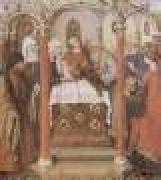 |
DARET, Jacques
|
|
Netherlandish Northern Renaissance Painter, ca.1404-1470
was an Early Netherlandish painter born in Tournai (now in Belgium), where he would spend much of his life. Daret spent 15 years as a pupil in the studio of Robert Campin, alongside Rogier or Rogelet de le Pasture (assumed by scholars to be Rogier van der Weyden, both words meaning "field" or "meadow" in French and Dutch respectively), and afterwards became a master in his own right. He became a favorite of the Burgundian court, and his patron for 20 years was the abbot of St. Vaast in Arras, Jean de Clercq. Though many works of Daret are mentioned in Jean de Clercq's account books, only four panels of Daret's works are known to have survived: all are from the so-called Arras Altarpiece or Saint-Vaast Altarpiece, painted for the abbot between 1433 and 1435. These paintings show a striking resemblance to the Flemish realism of the Master of Flemalle. This is argued by most scholars to be evidence that the Master of Flemalle was Daret's master, Robert Campin. Daret features rather more in the art historical debates over his period than the merit of his work alone would justify because he is relatively well-documented, and in particular can be securely identified as the creator of the altarpiece mentioned above, as well as a pupil of Campin. The stylistic similarity between him and the Master of Flemalle is therefore crucial evidence in the identification of the latter with Campin. This then becomes an important connection in establishing a link between Robert Campin/the Master of Flemalle and his other major pupil,
|
|
 |
Daret, Jean
|
|
Flemish Baroque Era Painter, 1613-1668
French painter. He came from Brussels and trained there before going on the traditional journey to Italy, which not only took him to Rome but also brought him into contact with contemporary masters at Bologna. While in Italy he produced a Self-portrait (1636; St Petersburg, Hermitage), which alludes to both his ideal model and the necessary basis of his work: his right hand rests on a fragment of antique sculpture, while beside his palette in the foreground lie several sheets of drawings. |
|
|
|
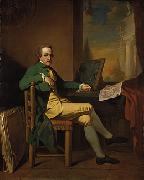 |
David Allan
|
|
13 February 1744 C 6 August 1796) was a Scottish painter, best known for historical subjects.
He was born at Alloa in central Scotland. On leaving Foulis's academy of painting at Glasgow (1762), after seven years' successful study, he obtained the patronage of Lord Cathcart and of Erskine of Mar, on whose estate he had been born. Erskine made it possible for him to travel to Rome (1764), where he remained for several years engaged principally in copying the old masters.
Among the original works which he then painted was the "Origin of Portraiture", now in the National Gallery at Edinburgh--representing a Corinthian maid drawing her lover's shadow--well known through Domenico Cunego's excellent engraving. This won him the gold medal given by the Academy of St Luke in the year 1773 for the best specimen of historical composition. |
|
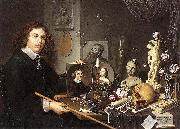 |
David Bailly
|
|
(1584-1657) was a Dutch Golden Age painter.
Bailly was born at Leyden in the Dutch Republic, the son of a Flemish immigrant, calligrapher and fencing master, Peter Bailly. As a draftsman, David was pupil of his father and the copper engraver Jacques de Gheyn.
David Bailly apprenticed with a surgeon-painter Adriaan Verburg in Leiden and then with Cornelius van der Voort (1576-1624), a portrait painter in Amsterdam. According to Houbraken, in the winter of 1608, Bailly took his Grand Tour, travelling to Frankfurt, Nuremberg, Augsburg Hamburg, and via Tirol to Venice, and from there to Rome. On his return he spent five months in Venice, all the while working as a journeyman where he could, before crossing the alps again in 1609. On his return voyage, Bailly worked for several German princes including the Duke of Brunswick. Upon his return to the Netherlands in 1613, Bailly began painting still-life subjects and portraits, including self-portraits and portraits of his students and professors at the University of Leiden. He is known for making a number of vanities paintings depicting transience of this life, with such ephemeral symbols as flowers and candles. Bailly taught his nephews Harmen and Pieter Steenwijck.
|
|
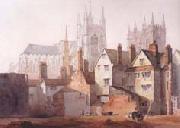 |
David Cox
|
|
David Cox [English Painter, 1783-1859]
English painter. After taking drawing lessons from Joseph Barber (1757/8-1811) in Birmingham, Cox worked briefly as an apprentice to a painter of lockets and snuff-boxes named Fieldler. This was followed about 1800 by a longer period painting scenery for the New Theatre, Birmingham. On the promise of similar employment at Astley's Amphitheatre in Lambeth, Cox travelled to London in 1804, but when this came to nothing he decided to make his name as a watercolour painter. He began exhibiting at the Royal Academy in 1805 and from 1809 until its demise in 1812 with the Associated Artists in Water-Colours, of which he became both member and president in 1810. He was elected an Associate of the Society of Painters in Water-Colours in 1812 and within a month had advanced to full membership. |
|
|
|
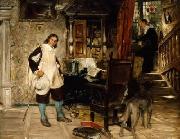 |
David Dalhoff Neal
|
|
(October 20, 1838 - May 2, 1915), was an American artist.
David Dalhoff Neal was born to father Stephen Bryant Neal and mother Mary (Dalhoff) Neal, on Middlesex Street, in Lowell, Massachusetts. His grandparents were Stephen Neal, and David Dalhoff and Sally (Bean) Dalhoff of Canterbury, New Hampshire, Dolhoffs that emigrated from Russia in 1763, for whom he was named. His mother's family, the Beans, migrated from Holland in the early 1830s. His aunt Elizabeth Dolhoff was very artistic, and his uncle Jesse Dolhoff was a great singer.
He attended Lowell grammar schools, and high school at Lawrence, Massachusetts. Deciding to devote himself to the study of art, he then attended art classes at the recently opened Andover Academy in Andover, New Hampshire. When Neal was 14, his father died and his fortunes were "impaired", so he set sail for New Orleans. Here at the age of 15, he worked the docks as a wharf clerk with a wood shipping firm dealing in Brazilian and Honduran mahogany. |
|
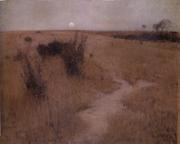 |
David Davies
|
|
Australian Painter, 1864-1939
Australian painter. He trained at the Ballarat School of Design, the National Gallery School, Melbourne, and the Acad?mie Julien, Paris. He was associated with the Heidelberg school in the 1890s, when he specialized in poetic evocations of evening, for example Moonrise. In 1897 he moved permanently to Europe, working in St Ives, Cornwall, England; the Conway Valley, Wales; and Dieppe, France, for 25 years and finally settling in Looe, Cornwall. He produced oils and watercolours of all these localities, as well as, portraits and flowerpieces. Among his more important European work in oil was St Ives Bay, |
|
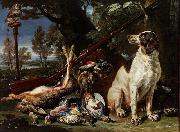 |
David de Coninck
|
|
(ca. 1644 Antwerp - after 1701, Brussels), also known as Rammelaar was a Flemish painter of the Baroque period. David Koninck was born in Antwerp and studied there under Jan Fyt. After a few years in Paris, he staid in Rome from ca 1671 to 1694, where joined the Bentvueghels with the nickname Rammelaar (rattle). He is sometimes stated to have died in Rome in 1687; however, he returned to his home country and is last recorded becoming a member of the painters guild in Brussels in 1701. His pictures are chiefly landscapes with animals and still life. He is likely unrelated to the generally contemporary Dutch painters, Philip de Koninck, or Philips Koninck (5 November 1619, Amsterdam - buried 4 October 1688, Amsterdam) and the fellow townsman Salomon de Koninck.
See Biography by Filippo Baldinucci.
|
|
|
|
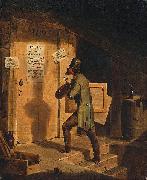 |
David Gilmour Blythe
|
|
(May 9, 1815 - May 15, 1865) was a self-taught American artist best known for paintings which satirically portrayed political and social situations.
Blythe was born in East Liverpool, Ohio on May 9, 1815 to poor parents of Scottish and Irish ancestry. After a childhood in a log cabin by the Ohio River, at the age of 16, Blythe moved to Pittsburgh, Pennsylvania. There he apprenticed himself to woodcarver Joseph Woodwell. In his subsequent work as an itinerant portrait painter, Blythe traveled widely from Baltimore to Philadelphia and perhaps as far as New Orleans. Other than his stint with Woodwell, Blythe had no known artistic education or training. |
|
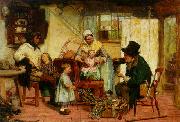 |
David Henry Friston
|
|
(1820 - 1906) was a British illustrator and figure painter in the Victorian Era. He is best remembered as the creator of the first illustrations of Sherlock Holmes in 1887, as well as his illustrations of the controversial female vampire story Carmilla (1872). He is also remembered for his illustrations accompanying reviews of Gilbert and Sullivan operas and plays of W. S. Gilbert in The Illustrated London News and the Illustrated Sporting and Dramatic News in the 1870s and 1880s.
|
|
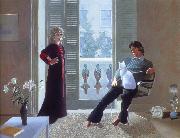 |
david hockney
|
|
Born: 9 July 1937
Birthplace: Bradford, England
Best Known As: British pop artist and critic |
|
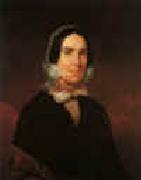 |
David Hunter Strother
|
|
1816-1888
Strother was born in Martinsburg, Virginia (now West Virginia). He studied drawing under Pietro Aneora in Philadelphia, Pennsylvania from 1829 to 1836 when he became a student of Samuel F. B. Morse in New York. Strother was an artist for The Crayon, the leading art journal of the United States at the time, and a frequent contributor to Harper's Monthly. Most of his early work was comprised of landscapes and other outdoor scenes. His art pertained mostly to Virginia and the Southern United States. Prior to the American Civil War, his art was published in books titled The Blackwater Chronicle (1853) and Virginia Illustrated (1857).
During the Civil War, Strother was commissioned by the U.S. Army and assigned as a topographer due to his detailed knowledge of the Shenandoah Valley. During this time, Strother recorded his experiences in the war which he would later publish in Harper's Monthly as "Personal Recollections of the War." His accounts are considered to be unique and are highly praised for their objective viewpoint. He was involved in 30 battles, though never wounded, and was brevetted brigadier general by the War's end.
After the war, topics of his pieces covered a wider range of subjects. Strother began to make works which commented on politics and race relations. He even sketched a portrait of Chief Sitting Bull. Some of his drawings were merely of individuals and groups going about their daily lives.
Strother ended his career as an artist when he was appointed by President Rutherford B. Hayes to be the General Consul to Mexico City in 1879. He returned to West Virginia in 1885 and died there three years later. The New York Times published an obituary in which it is stated that his name was a household one during his career. Strother is buried in Green Hill Cemetery in Martinsburg, West Virginia. |
|
 |
David Johnson
|
|
American Landscape painter.
b.1827 d.1908
was a member of the second generation of Hudson River School painters. He was born in New York City, New York. He studied for two years at the antique school of the National Academy of Design. He also studied briefly with the Hudson River artist Jasper Francis Cropsey. Along with John Frederick Kensett and John William Casilear, he was best known for the development of Luminism. By 1850, Johnson was exhibiting regularly at the National Academy of Design in New York, where he became an associate in 1860. |
|
 |
David Klocker Ehrenstrahl
|
|
German, 1629-1698,Swedish nobleman and portrait painter who in 1652, at twenty-four years of age, at the request of Carl Gustaf Wrangel, moved to Skokloster Castle, from his art studies in the Netherlands. Between 1654 and 1661 he studied in Italy and visited the courts of both France and England. On his return he became entitled Court painter. He was raised to the nobility in 1674 and became court indendant in 1690. Mikael Dahl and David von Krafft as well as his daughter Anna Maria (born 1666) can be found among his pupils. The allegoric great hall ceiling fresco, named The Great Deeds of The Swedish Kings, in the Swedish House of Knights, made between 1670 and 1675, is considered to be his greatest work. A second version was made in Drottningholm Palace, the home of the Swedish Royal Family, in 1695. The Drottningholm fresco, also became the motive of the 1000th and ever largest postage stamp by Czeslaw Slania, the Polish |
|
|
|
|
|
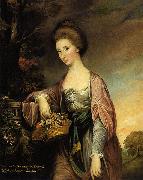 |
David Martin
|
|
painted Portrait of Elizabeth Rennie, Viscountess Melville in 1750-1847
|
|
|
|
 |
David Octavius Hill
|
|
Scottish Painter and Photographer,
1802-1870
was a founding member of the Royal Scottish Academy and its secretary for 40 years. In 1843 he enlisted the help of Robert Adamson (b. 1821, Berunside, Scot. January 1848, St. Andrews), a chemist experienced in photography, in photographing the delegates to the founding convention of the Free Church of Scotland. They used the calotype process, by which an image was developed from a paper negative. In these and other portraits they demonstrated a masterly sense of form and composition and a dramatic use of light and shade. Their five-year partnership resulted in some 3,000 photographs, including many views of Edinburgh and small fishing villages. |
|
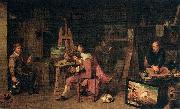 |
David Rijckaert
|
|
David Ryckaert III, sometimes called The Younger (2 December 1612 (baptised) - 11 November 1661) was a Flemish painter.
A member of the Ryckaert family of artists, he was born and raised in Antwerp, the city in which he conducted his career and in which he died. He was the son of David Ryckaert II, grandson of David Ryckaert I, and nephew of Martin Ryckaert.
David Ryckaert was a pupil of his homonymous father; his work was influenced by the styles of Adriaen Brouwer and both David Teniers the Elder and David Teniers the Younger. Ryckaert is noted for large and often humorous genre pictures of farmers and landlords, and powerfully coloured still lifes. He also painted a range of other subjects, including religious pictures; his The Temptation of Saint Anthony (1650) is in the collection of the Palazzo Pitti in Florence.
|
|
|
|
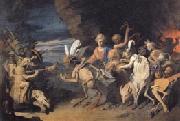 |
David Ryckaert
|
|
Flemish Baroque Era Painter, 1612-1661
was a Flemish painter. A member of the Ryckaert family of artists, he was born and raised in Antwerp, the city in which he conducted his career and in which he died. He was the son of David Ryckaert II, grandson of David Ryckaert I, and nephew of Martin Ryckaert. David Ryckaert was a pupil of his homonymous father; his work was influenced by the styles of Adriaen Brouwer and both David Teniers the Elder and David Teniers the Younger. Ryckaert is noted for large and often humorous genre pictures of farmers and landlords, and powerfully coloured still lifes. He also painted a range of other subjects, including religious pictures; his The Temptation of Saint Anthony (1650) is in the collection of the Palazzo Pitti in Florence. |
|
 |
David Teniers
|
|
Belgian
1610-1690
David Teniers Gallery
Flemish painter. His father, also named David Teniers (1582 ?C 1649), was a painter of primarily religious subjects. The younger Teniers was highly prolific and is best known for his genre scenes of peasant life, many of which were used for tapestry designs in the 18th century. He was brilliant at handling crowd scenes in an open landscape and adept at characterizing his figures with a warm, human, and often humorous touch. As court painter to the archduke Leopold William, he also made many small-scale copies of paintings in the archduke collection; engraved and published as Theatrum Pictorium (1660), they constitute a valuable source as a pictorial inventory of a great 17th-century collection. |
|
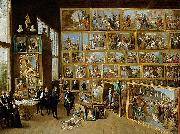 |
David Teniers the Younger
|
|
(December 15, 1610 C April 25, 1690), a Flemish artist born in Antwerp, was the more celebrated son of David Teniers the Elder, almost ranking in celebrity with Rubens and Van Dyck. His son David Teniers III and his grandson David Teniers IV were also painters. His wife Anna nee, Anna Breughel was the daughter of Jan Brueghel the Elder and the granddaughter of Pieter Bruegel the Elder.
Through his father, he was indirectly influenced by Elsheimer and by Rubens. The influence of Adriaen Brouwer can be traced to the outset of his career. There is no evidence, however, that either Rubens or Brouwer interfered in any way with Teniers's education, and Smith (Catalogue Raisonne) may be correct in supposing that the admiration which Brouwer's pictures at one time excited alone suggested to the younger artist his imitation of them. The only trace of personal relations having existed between Teniers and Rubens is the fact that the ward of the latter, Anne Breughel, the daughter of Jan (Velvet) Breughel, married Teniers in 1637.
|
|
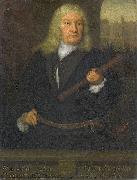 |
David van der Plas
|
|
David van der Plas (1647-1704), was a Dutch Golden Age portrait painter.
David van der Plas became famous as a portrait painter, and his most illustrious patron was Cornelis Tromp. In 1684 he married Cornelia van der Gon of Haarlem, the daughter of the castellan (kastelein) of the Oude Doelen, the meeting quarters of the Haarlem schutterij (the building currently houses the Stadsbibliotheek Haarlem). David van der Plas' brother-in-law was the painter Govert van der Leeuw and his pupil was Jacob Appel.
His wife Cornelia van der Gon was the rich heiress of the Amsterdam architect Adriaan Dortsman (ca. 1636-1682), who designed the round Lutheran church on the Singel. The marriage was childless, and Cornelia spent her time on her doll houses, which Dortsman had helped design and which Van der Plas helped decorate. The landscape painter Jan Wijnants also painted miniatures for these doll houses. Cornelia died in 1701, and after the death of Van der Plas, the doll houses were sold at auction to Sara Rothe, who used them to decorate her own doll houses. |
|
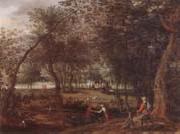 |
David Vinckboons
|
|
Flemish Baroque Era Painter, 1576-ca.1632
was a Dutch painter of Flemish origin. Vinckboons was one of the most prolific and popular painters and print designers in the Netherlands. Himself influenced by Pieter Bruegel the Elder, he was instrumental together with "Hans Bol and Roelant Savery" in the development of genre painting in the northern Netherlands. The family moved to Antwerp around 1580, and then to Middelburg after the Spanish occupation of Antwerp in 1585. It is not likely they moved for religious reasons to Amsterdam. His father became a citizen in 1591, but none of his grandchildren were baptized in a Calvinist church. In 1602 David married in Leeuwarden to Agneta van Loon, the daughter of a notary. Then he lived in Sint Antoniesbreestraat like many other artists and painters. According to Karel van Mander he did not have any teacher other than his father Phillipe, a painter on canvas with watercolors, an art form practised mainly in his birthplace of Mechelen. David specialized in elegant figures in park-like landscapes (Outdoor Merry Company, 1610; Vienna, Akademie der Bildenden Kenste) as well as Kermis and other village festivals. His landscapes reflect his contact with Gillis van Coninxloo. Vinckboons attracted a number of students; among them were Gillis d'Hondecoeter, Claes Janszoon Visscher and probably Esaias van de Velde. |
|
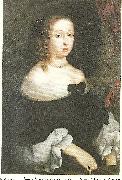 |
david von krafft
|
|
David von Krafft, konstnär, målare, född 1655 i Hamburg, död 1724 i Stockholm.
David von Krafft blev kallad till Sverige 1675 av hofkonterfejaren (hovmålaren) David Klöcker Ehrenstrahl, som dessutom var hans morbror och nu även blev hans lärare i den ädla konsten att måla. Senare studerade von Krafft vidare ett tiotal år i utlandet, särskilt i Italien, slutligen blev han Ehrenstrahls ersättare som hovmålare.
Nu fick han en massa beställningar och uppdrag och han målade sakliga och säkert tecknade porträtt, som tyvärr dock är ganska entoniga och kalla i koloriten. Bland hans bästa arbeten är porträttet av Karl XII (finns i Lund) samt av Carl Gustaf Armfeldt d.ä. (Drottningholms slott). I Kalmar domkyrka har han målat altartavlan (dock efter en komposition av en italiensk konstnär).
David von Krafft finns representerad vid Nationalmuseum, Malmö Museum, Göteborgs konstmuseum och på Gripsholm. Krafft hade ett stort antal lärjungar och bland dem Gustaf Lundberg och Olof Arenius. |
|
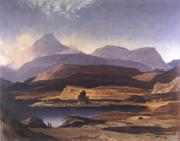 |
David Young Cameron
|
|
British master of landscape and architectural views.
Glasgow ,1865-1945
is a Scottish painter and etcher. He was trained at the Glasgow and Edinburgh Schools of Art in the 1880s. From 1887-1892 he was a member of the Royal Society of Painter-Etchers. It was during this time that he published a number of sets of etchings (such as "The Clyde Set", "The North Holland Set" and "The North Italian Set"). In general his prints feature areas of great darkness, offset by highlights. Cameron would later become known for his church interiors and barren landscapes of Scotland done in drypoint. The feathery lightness of these drypoints was in visual contrast with the rock and water of the subjects. He became highly sought after by collectors, until the Great Crash in 1929 brought a collapse in prices for prints in general. He exploited his popularity by producing an unprecedented number of states of his prints, and is believed to hold the record at twenty-eight states in one case. Cameron became a Royal Academician in 1920.
|
|
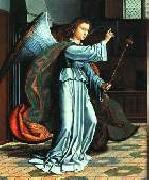 |
DAVID, Gerard
|
|
Netherlandish Northern Renaissance Painter, ca.1460-1523
Netherlandish painter. He is known as the last of the 'Flemish Primitives'. Although born in the northern Netherlands, he moved to Bruges as a young man, and most of his work expresses the impassive, unmannered, microscopically realistic approach peculiar to south Netherlandish art in the time of Jan van Eyck. David was skilled at synthesizing the art of several important south Netherlandish predecessors, adapting, for instance, the compositions of van Eyck and the technique of Hugo van der Goes. He was also influenced by Hans Memling, |
|
 |
David, Jacques-Louis
|
|
French Neoclassical Painter, 1748-1825
Jacques-Louis David is famous for his huge, dramatic canvasses of Napoleon and other historical figures, including Oath of the Horatii (1784), Death of Marat (1793) and The Sabine Women (1799). Early in his career he was a leader in the neoclassical movement; later his subjects became more modern and political. David was himself active in the French Revolution as a supporter of Robespierre and is sometimes called the chief propagandist for the Revolution; after the Reign of Terror ended he was briefly imprisoned for his actions. When Napoleon took power David became his court painter and created several grand canvasses of the Emperor, including the heroic Napoleon Bonaparte Crossing the Alps (1801) and the enormous Coronation of Napoleon and Josephine (1807). David also painted Napoleon in His Study (1812), |
|
 |
Davies Arthur Bowen
|
|
American Symbolist Painter, printmaker and tapestry designer , b.1862 d.1928
American painter and illustrator. He first trained as an architectural draughtsman at the Academy of Design, Chicago (1878). After studying briefly at the Art Institute of Chicago, he went to New York, where he attended the Gotham School and the Art Students League (1886-8). By 1887 he was working as an illustrator for Century magazine. A realist landscape painter in the 19th-century academic tradition, he was influenced by the painters of the Hudson River school and particularly by the luminist, dream-like landscapes of George Inness. |
|
|
|
 |
De Scott Evans
|
|
1847-1898
was an American artist who worked in Indiana, Ohio and New York. He was known for portraits, still lifes, landscapes and other genres.
Born in Boston, Indiana to David S. and Nancy A. (Davenport) Evans. His father was a physician. Evans changed his signature to D. Scott Evans and later to De Scott Evans. He also signed paintings with the names David Scott, S. S. David, and Stanley S. David. He attended Miami University's preparatory school in the 1860s, studying with professor Adrian Beaugureau at Miami and later in Cincinnati.
In 1873, he became head of the art department at Mount Union College and after several terms there, he moved to Cleveland to teach and to paint. From Cleveland, he moved to New York. He died along with 500 other passengers and crew, including his daughters when the French steamer La Bourgogne was rammed by a sailing ship in July 1898.
Though he died at sea, there is a marker for him and his daughters in the Oxford Cemetery in Oxford, Ohio. |
|
|
|
|
|
|
|
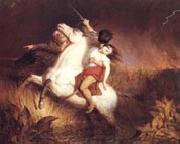 |
Deas Charles
|
|
American Painter
1818-1867
After an unsuccessful attempt to obtain an appointment at West Point Military Academy, he turned to an artistic career. He quickly earned recognition at the annual exhibitions of the National Academy of Design, New York, to which he was elected an associate member in 1839, with subjects taken from James Fenimore Cooper, |
|
|
|
 |
Defendente Ferrari
|
|
(c. 1480/1485 - c. 1540) was an Italian painter active in Piedmont.
Ferrari was born at Chivasso, near Turin, and worked in the workshop of Giovanni Martino Spanzotti.
He met considerable success as a painter of polyptychs and altarpieces, characterized by a highly decorative style inspired by Northern Europe masters.
|
|
|

